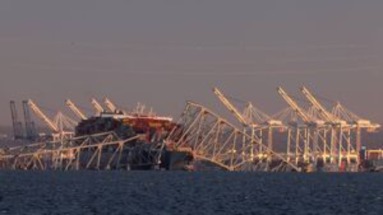
Advertisement
In a harrowing turn of events, a cargo ship’s collision with Baltimore’s Francis Scott Key Bridge has left a trail of devastation, claiming the lives of several workers and plunging the city into mourning. Divers, working tirelessly against treacherous conditions, have recovered the remains of two of the six missing workers more than a day after the catastrophic incident.
The bodies of the unfortunate victims, identified as Alejandro Hernandez Fuentes, 35, of Baltimore, and Dorlian Ronial Castillo Cabrera, 26, of nearby Dundalk, were found submerged in a red pickup truck in the icy waters of the Patapsco River. These individuals, hailing from Mexico and Guatemala respectively, were among the construction crew tasked with repairing potholes on the bridge when tragedy struck.
The heartbreaking reality of the situation was underscored by the origins of the deceased workers, as revealed during a somber press conference. The victims represented a tapestry of nations, with workers hailing from Mexico, Guatemala, Honduras, and El Salvador, highlighting the international scope of the tragedy.
As authorities grapple with the aftermath of the disaster, efforts to recover additional bodies from the 50-foot-deep waters surrounding the bridge have been suspended due to perilous conditions. The sheer scale of the collapse, which saw eight individuals plummet 185 feet into the river, underscores the magnitude of the catastrophe.
Remarkably, amidst the chaos, two workers were rescued from the water on Tuesday, albeit with varying degrees of injury. Their survival can be attributed, in part, to the swift response of authorities who promptly halted vehicular traffic on the bridge upon receiving a distress call from the cargo ship.
The timeline of events leading up to the bridge collapse paints a grim picture of the unfolding tragedy. Shortly after 1 a.m. EDT on Tuesday, the container ship Dali experienced a total power failure while navigating the Patapsco River en route to Sri Lanka. Within minutes, the vessel collided with a pylon of the bridge, triggering its collapse into the river below.
The gravity of the situation is further underscored by comparisons to past bridge collapses, notably the 2007 I-35W bridge disaster in Minneapolis, which claimed 13 lives. Tuesday’s catastrophe stands as a stark reminder of the inherent risks associated with infrastructure failures and the need for robust safety measures to prevent future tragedies.
As Baltimore grapples with the aftermath of this devastating event, the nation mourns the loss of lives and contemplates the urgent need for enhanced safety protocols to safeguard against similar incidents in the future.
